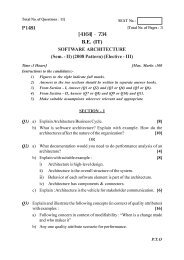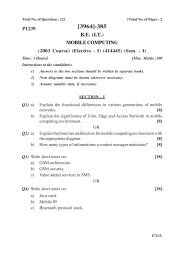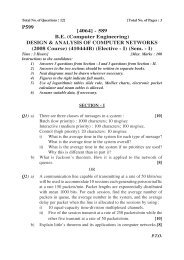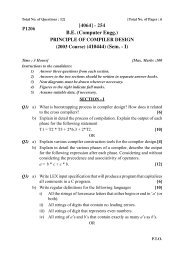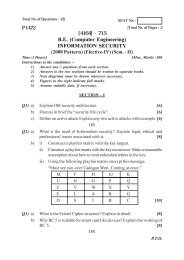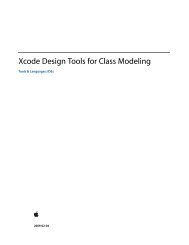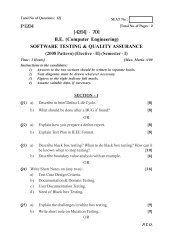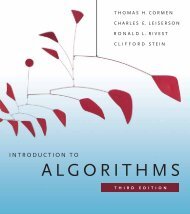Cloud Computing and SOA Convergence in Your Enterprise: A Step ...
Cloud Computing and SOA Convergence in Your Enterprise: A Step ...
Cloud Computing and SOA Convergence in Your Enterprise: A Step ...
Create successful ePaper yourself
Turn your PDF publications into a flip-book with our unique Google optimized e-Paper software.
92 Chapter 5 Work<strong>in</strong>g from <strong>Your</strong> Data to the <strong>Cloud</strong>s<br />
triples. An OWL ontology is made up of several components, some of which are<br />
optional <strong>and</strong> some of which may be repeated.<br />
Us<strong>in</strong>g these Web-based st<strong>and</strong>ards as the jump<strong>in</strong>g-off po<strong>in</strong>t for ontology<br />
<strong>and</strong> cloud comput<strong>in</strong>g, it is possible to def<strong>in</strong>e <strong>and</strong> automate the use of ontologies<br />
<strong>in</strong> both <strong>in</strong>tracompany <strong>and</strong> <strong>in</strong>tercompany doma<strong>in</strong>s. Doma<strong>in</strong>s made up of<br />
thous<strong>and</strong>s of systems, all with their own semantic mean<strong>in</strong>gs, are bound<br />
together <strong>in</strong> a common ontology that makes short work of cloud comput<strong>in</strong>g<br />
<strong>and</strong> def<strong>in</strong>es a common semantic mean<strong>in</strong>g of data <strong>in</strong> <strong>and</strong> between on-premise<br />
<strong>and</strong> cloud-based systems.<br />
Extend<strong>in</strong>g from the languages, we have several libraries available for a variety<br />
of vertical doma<strong>in</strong>s, <strong>in</strong>clud<strong>in</strong>g f<strong>in</strong>ancial services <strong>and</strong> e-bus<strong>in</strong>ess. We also<br />
have many knowledge editors that support the creation of ontologies, as well as<br />
the use of natural-language process<strong>in</strong>g methodologies. We have seen these <strong>in</strong><br />
commercially available knowledge mapp<strong>in</strong>g <strong>and</strong> visualization tools us<strong>in</strong>g st<strong>and</strong>ard<br />
notations such as Unified Model<strong>in</strong>g Language (UML).<br />
Ontologies <strong>and</strong> Web st<strong>and</strong>ards that support ontologies are noth<strong>in</strong>g new.<br />
However, consider<strong>in</strong>g that cloud comput<strong>in</strong>g provides a centralized location to<br />
create <strong>and</strong> share ontologies, I suspect it will become more important to architecture<br />
<strong>in</strong> general <strong>and</strong> to architecture that leverages cloud comput<strong>in</strong>g.<br />
Underst<strong>and</strong><strong>in</strong>g the Data<br />
We know that if we look at cloud comput<strong>in</strong>g, we need to underst<strong>and</strong> where<br />
the data exists, gather <strong>in</strong>formation about the data (e.g., schema <strong>and</strong> metadata<br />
<strong>in</strong>formation), <strong>and</strong> apply bus<strong>in</strong>ess pr<strong>in</strong>ciples to determ<strong>in</strong>e which data<br />
flows where <strong>and</strong> why (see Figure 5.4). This step fits <strong>in</strong>to the larger steps that<br />
are depicted <strong>in</strong> Figure 5.5.<br />
In short, implement<strong>in</strong>g a cloud-based solution dem<strong>and</strong>s more than the<br />
movement <strong>and</strong> persistence of data with<strong>in</strong> all systems <strong>in</strong> the problem doma<strong>in</strong>.<br />
A successful solution requires that the enterprise also def<strong>in</strong>e how that <strong>in</strong>formation<br />
flows through it <strong>and</strong> how it is related to core services <strong>and</strong> core bus<strong>in</strong>ess<br />
processes (def<strong>in</strong>ed <strong>in</strong> Chapters 6 <strong>and</strong> 7).<br />
In essence, what we are do<strong>in</strong>g here is gett<strong>in</strong>g down to the details about the<br />
exist<strong>in</strong>g data, or data that is a part of new <strong>in</strong>formation systems. We are not analyz<strong>in</strong>g<br />
this <strong>in</strong>formation as a component that will certa<strong>in</strong>ly reside <strong>in</strong> the clouds,<br />
but to provide a base of underst<strong>and</strong><strong>in</strong>g to consider whether the <strong>in</strong>formation



